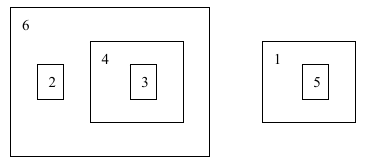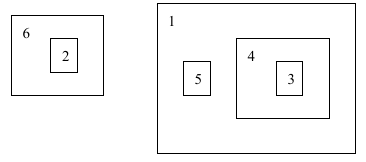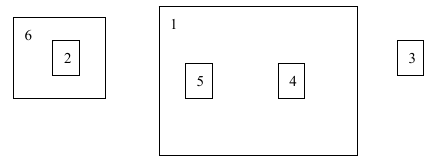771 . Box
Description
There are N
Jack can perform the ``MOVE x y
In the following picture, box 2 and 4 are directly inside box 6, box 3 is directly inside box 4, box 5 is directly inside box 1, box 1 and 6 are on the ground.
<!-- MATH
$\epsfbox{p4393a.eps}$
-->

The picture below shows the state after Jack performs ``MOVE 4 1":
<!-- MATH
$\epsfbox{p4393b.eps}$
-->

Then he performs ``MOVE 3 0", the state becomes:
<!-- MATH
$\epsfbox{p4393c.eps}$
-->

During a sequence of MOVE operations, Jack wants to know the root box of a specified box. The root box of box x
Input Format
Input contains several test cases.
For each test case, the first line has an integer N
$(1 \le N \le 50000)$
-->
(1 <= N<= 50000)
Next line has N
$a_{1}, a_{2}, a_{3}, \ldots, a_{N}$
-->
a1, a2, a3,..., aN
$(0 \le a_{i} \le N)$
-->
(0 <= ai <= N)
Next line has an integer M
$(1 \le M \le 100000)$
-->
(1 <= M <= 100000)
On the next M
- MOVE x y
, <!-- MATH
$1 \le x \le N$
-->1 <= x <= N
, <!-- MATH
$0 \le y \le N$
-->
0 <= y <= N
, which is described above. If an operation is illegal, just ignore it.
- QUERY x
, <!-- MATH
$1 \le x \le N$
-->1 <= x <= N
, output the root box of box x
.
Output Format
For each query, output the result on a single line. Use a blank line to separate each test case.
Sample Input 1
2 0 1 5 QUERY 1 QUERY 2 MOVE 2 0 MOVE 1 2 QUERY 1 6 0 6 4 6 1 0 4 MOVE 4 1 QUERY 3 MOVE 1 4 QUERY 1
Sample Output 1
1 1 2 1 1
Hints
Beware of constants!
Try "Robotic Sort" first if you still don't have any idea:)
Problem Source
Migrated from old NTUJ.
ICPC 2008, Chengdu
Subtasks
| No. | Testdata Range | Score |
|---|